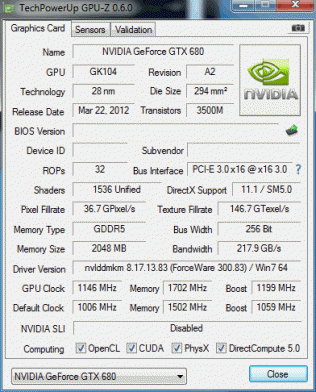

- #NVIDIA GTX 680 COMPARE 1080P#
- #NVIDIA GTX 680 COMPARE PC#
- #NVIDIA GTX 680 COMPARE FREE#
#NVIDIA GTX 680 COMPARE PC#
To make things more interesting, we compare the action with two similar playthroughs on the same Core i7 3770K PC running the GTX 780 Ti and the Radeon R9 290X.

Here we stack up all settings to the max, turn on v-sync, and utilise SMAA T2X anti-aliasing - the game's best balance between performance and quality.
#NVIDIA GTX 680 COMPARE 1080P#
It's an interesting approach, but its effectiveness will be limited by the 'compressability' of the material it has to work with - as you'll see later.īut to begin with, let's see how the GTX 980 copes with that most intensive of GPU workouts - the 1080p Crysis 3 gameplay challenge. And while the 256-bit memory interface may seem rather narrow for a high-end performance part, lossless compression is utilised on the bus to get higher throughput.

This new, larger chip could almost be considered a Maxwell 2.0 part - it retains all the advantages of its predecessor (a revised approach to its CUDA cores, a big boost to L2 cache) but it also features power-saving features culled from Nvidia's work on the Tegra K1 mobile part found in the Shield tablet. So what's the secret sauce here? Well, from the GeForce GTX 750 Ti we already know that the Maxwell architecture offers a 2x performance per watt boost compared to Nvidia's last tech, codenamed Kepler.
#NVIDIA GTX 680 COMPARE FREE#
Order the GTX 980 4GB from Amazon with free shipping. This content is hosted on an external platform, which will only display it if you accept targeting cookies. Put simply - the GTX 980 is cheaper for Nvidia to produce, and while you don't get any pricing benefits as a consumer (the new GTX 970 is Nvidia's value play - we'll review that soon), you do benefit from a much cooler, less expensive card to run. Despite this, the GTX 980 powers ahead of both those cards in almost all of the tests we put it through. What's more, the new Maxwell card utilises a relatively narrow 256-bit memory bus up against the 384-bit interface of its predecessor and the whopping great 512-bit bus of the R9 290X. The GM204 chip is around 72 per cent the size of the Titan/GTX 780 Ti processor, and around 91 per cent of the area of the Radeon R9 290X's Hawaii chip. The new Maxwell chip achieves more - a lot more - with a lot less, despite using the same 28nm chip technology as its predecessor. It's on the inside where the GTX 980 really impresses - its efficiency goes far beyond its meagre power consumption alone. However, it carries more RAM and a much more efficient design actually sees it pull ahead of the prior Nvidia flagship. The GTX 980 reveals the debut of the 'big' Maxwell aimed at the high-end enthusiast.Ĭodenamed GM204, the new Maxwell has two billion fewer transistors than the top-end GTX 780 Ti, and features a much narrower memory bus (256-bit vs 384-bit) and is physically a much smaller chip (398mm 2 vs 552mm 2). Nvidia's Maxwell architecture debuted in the rather splendid GTX 750/750 Ti budget card released earlier this year, based on the GM107 chip. Also of interest is that the HDMI port is based on the 2.0 standard, meaning support for 4K resolution at 60Hz. The new array of ports has been designed to facilitate easier set-up of surround G-Sync - which still requires DisplayPort to function. A plastic tab on the rear of the unit can be removed in order to facilitate better airflow, but the major differences come on the back-plate: Nvidia's established line-up of dual DVI, HDMI and DisplayPort gives way to a new arrangement: one DVI, one HDMI and three DisplayPorts. From an aesthetic standpoint, differences are relatively minor - the PCB backing of the older Nvidia cards has given way to a plastic shroud that more fully encloses the components. Our review card features the premium metallic chassis introduced with the GTX Titan - clean, industrial, cool and quiet. The GTX 980's TDP limit is a mere 165W, so the implications here are obvious - the GTX 980 is capable of being deployed in a much larger variety of PCs: living-room small form factor units being the obvious example. Hot chips need cooling, in turn requiring elaborate cooling assemblies, which can produce unwanted noise. Performance graphics cards typically consume an absolute maximum of 250W - at full-pelt, that translates into an awfully large amount of heat. Maxwell's power efficiency shouldn't be so readily discounted though. This is a refined, ultra-power efficient replacement with a relatively small performance bump, as opposed to the next big new thing in graphics technology. It's the fastest single-chip graphics card money can buy - but the takeaway for many will be that there's no revelatory performance increase over Nvidia's existing top-end hardware. Nvidia has discontinued its flagship GTX 780 Ti, replacing it with the brand-new GTX 980, powered by its new Maxwell architecture.







 0 kommentar(er)
0 kommentar(er)
